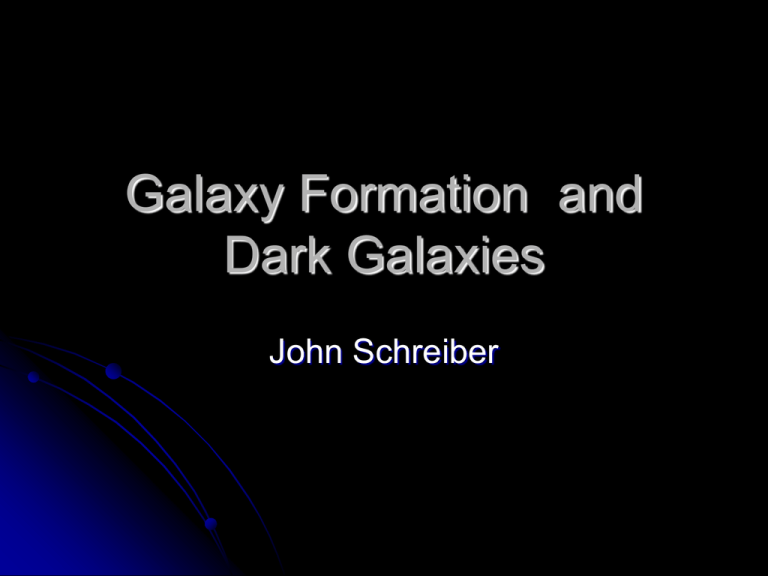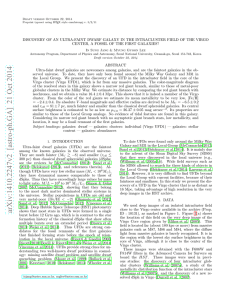JSchreiberTalk3.ppt
advertisement

Galaxy Formation and Dark Galaxies John Schreiber Outline Background info (formation/evolution of galaxies) Implications of theories More dwarf galaxies should be observed These may exist as difficult-to-detect “dark galaxies” VIRGOHI21 Rotating H cloud in the Virgo cluster Possible dark galaxy Discrepancies Background info What is a galaxy? Basic unit of cosmology Can contain stars, gas, dust, dark matter Formation of Galaxies Before As universe expands, density enhancements either grew or dispersed. Smaller, more dense density enhancements first to collapse. These first “lumps” that broke free contained some H and He, but mostly dark matter. Protogalaxies When this “lump” collapses under its own gravity Appear abt. 14 mill. years b.p. Should be detectable via their heat signature Evolution of Galaxies Star Formation Clouds of gas orbit in the protogalaxy Density of some of these clouds increases as gas falls towards the core of the protogalaxy Clouds collide Primeval galaxy Collision creates a high density region where a star cluster forms Remaining gas heated by stars (dissipates) Initial rate of star formation Slow—cons. ang. momentum forces a spiral disk Fast---elliptoid Implications of Current Theory More dwarf galaxies should exist than currently observed May exist as dark galaxies Starless clouds of H and dark matter Observed via radio waves (w/ wavelength of ~ 21 cm) No dark galaxies have currently been discovered Other possibilities Galactic cannibalism Unaccounted for environmental factor Little empirical info about “young galaxies” VIRGOHI21-Dark Galaxy? Possible dark galaxy Rotating cloud in the Virgo cluster Contains enough H to form 100 mill. Sunsized stars Recently located by a team led by Robert Minchin Used the radiotelescope at the University of Manchester After examining it w/ optical telescope“confident” it is a dark galaxy VIRGOHI21-Other Possibilities? May not be a dwarf May be two passing H clouds Mass from dark matter prevents rotation from tearing galaxies apart Measured speed of rotation implies ~1/10 dark matter of Milky Way This implies 100x more H should be present Would give illusion of rotation Counter-arguments Few known H clouds If H gas ionized it would be “invisible to radio telescopes” Sources http://www.newscientist.com/article.ns?id=dn7056 http://abyss.uoregon.edu/~js/ast123/lectures/lec25.html http://pinot.phys.uvic.ca/~jfn/mywebpage/gxform.html http://www.oarval.org/galaxfrm.htm http://hermes.physics.ox.ac.uk/users/Astrophysics/guide s/universe/galformation.shtml http://www.absoluteastronomy.com/encyclopedia/G/Ga/ Galaxy_formation_and_evolution.htm http://www.astro.cf.ac.uk/computing/parallel/gal2/Sbc.ht ml






